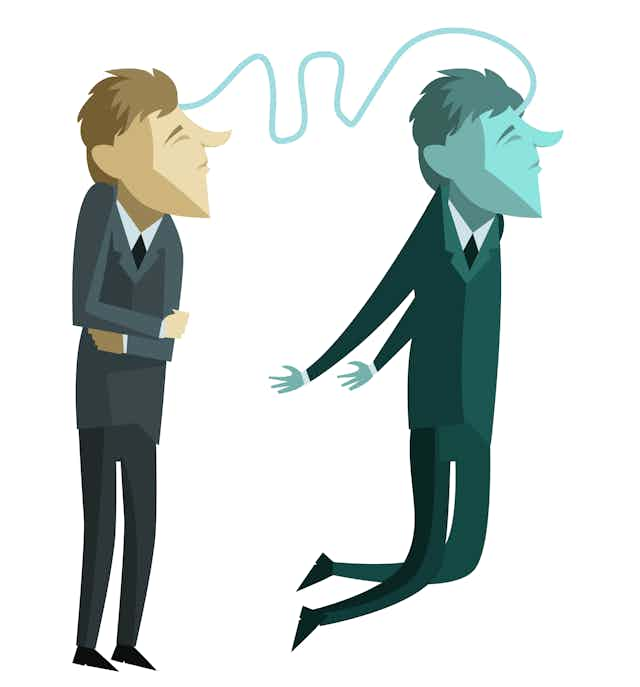Can a person be in two places at the same time? This is the question at the heart of Stephen King’s latest bestseller, The Outsider. King’s story begins with the public arrest of Terry Maitland, a popular small-town baseball coach, for a murder committed a few days earlier. Maitland is placed at the scene of the murder by multiple witnesses, fingerprints, and DNA evidence.
However, Maitland also has an airtight alibi – at the time of the murder he was in another city 70 miles away, his presence there supported by numerous witnesses, fingerprints, and video evidence. So unshakeable is the evidence for Maitland’s simultaneous presence both at the murder scene and at the other location, that the investigators eventually find themselves forced to entertain the question of whether one person can be in two places at the same time.
Curiously, bilocation – the phenomenon of one person being in two places at the same time – also featured prominently in one of the highest grossing films of 2017, The Last Jedi, the eighth instalment of the Star Wars saga. At the end of the film, we saw Luke Skywalker fighting Kylo Ren on the planet Crait while simultaneously meditating on another planet, Ahch-To.
Bilocation and multilocation
As surprising as it may sound, bilocation has intrigued and exercised philosophers, scientists and theologians for centuries. There are two reasons for this. First are the numerous reports of bilocation, most of which concern saints, mystics, or other pious persons. For example, in the biography of the 16th-century Saint Francis Xavier, co-founder of the Jesuit order, it is claimed that he was in two places at the same time, performing missionary work in two locations many miles apart. More famously, in the 20th century it was claimed that Padre Pio, a Capuchin priest, had bilocated on many occasions, both within his native Italy and beyond.

The second reason thinkers have taken bilocation so seriously is because it is implied by a traditional interpretation of the Catholic doctrine of the Eucharist – which holds that Christ’s body and his blood are really present in the bread and wine wherever the Eucharist is validly celebrated. Since the Eucharist is validly celebrated in many different places at the same time, it must be that Christ’s body is really present in many different places at once. Because such a phenomenon would involve being in more than two places at the same time, it is often referred to as “multilocation”.
Explaining and rejecting bilocation
While bilocation has often been heralded as a miracle (as has multilocation), others have simply dismissed the possibility of it outright. The great Christian theologian, St Augustine, was suspicious of reports of bilocation and suggested that they were due to demonic deception. In the 17th century, the philosopher John Locke argued that it was a matter of logic that a person could not be in two places at the same time. Others have suggested that cases of bilocation involve a kind of mental projection, and even Padre Pio seemed to insinuate as much when he explained his episodes of bilocation as “an extension of his personality”.

One of the most intriguing attempts to get to grips with the idea of bilocation can be found in the work of maverick Enlightenment philosopher André-Pierre Le Guay de Prémontval. Prémontval wrote an essay in which he claimed to show how it was possible for him “to be present, and really present, as much in Paris as in Rome and as much in Rome as in Paris” for the whole of an hour.
Prémontval’s explanation involved his body being transported backwards and forwards between the two cities at incredible speed. Because fast-moving objects leave an impression in the eye for a short time after they have moved on, to those in either city it would appear that he was there for the whole hour even though he would have been elsewhere for more than half the time.
Prémontval’s idea would seem to work in theory – think of the unbroken circle of light we see when a luminous object is rotated very quickly in a circle – but not in practice, as the speed of travel required is still beyond the ability of human beings. In any case, since his idea involves a person being moved very rapidly between two locations, even if it were put into practice it would not amount to true bilocation (someone actually being in two different places at the same time), but would constitute only apparent bilocation (someone appearing to be in two different places at the same time).
Stranger than fiction
It would be easy to dismiss these attempts to get to grips with bilocation as quaint but passé, were it not for the fact that modern physics tells us that it is a genuine feature of the natural world. The 2012 Nobel Prize for Physics was awarded to two physicists who proved that atoms and electrons can be in two places at the same time. By firing photons at an atom Serge Haroche and David J. Wineland were able to bring it to a state where it was simultaneously moving and not moving, occupying locations just 80 nanometers apart.
But, while bilocation may be a reality at the quantum level – and there seems to be nothing in principle to prevent it applying to much larger objects like our own bodies – scientists believe that technical limitations will prevent us from being able to put human beings in different places at the same time.
Not that this should concern King – who, as you would probably expect, preferred the supernatural to the esoteric when working out the paradox of bilocation in The Outsider.

